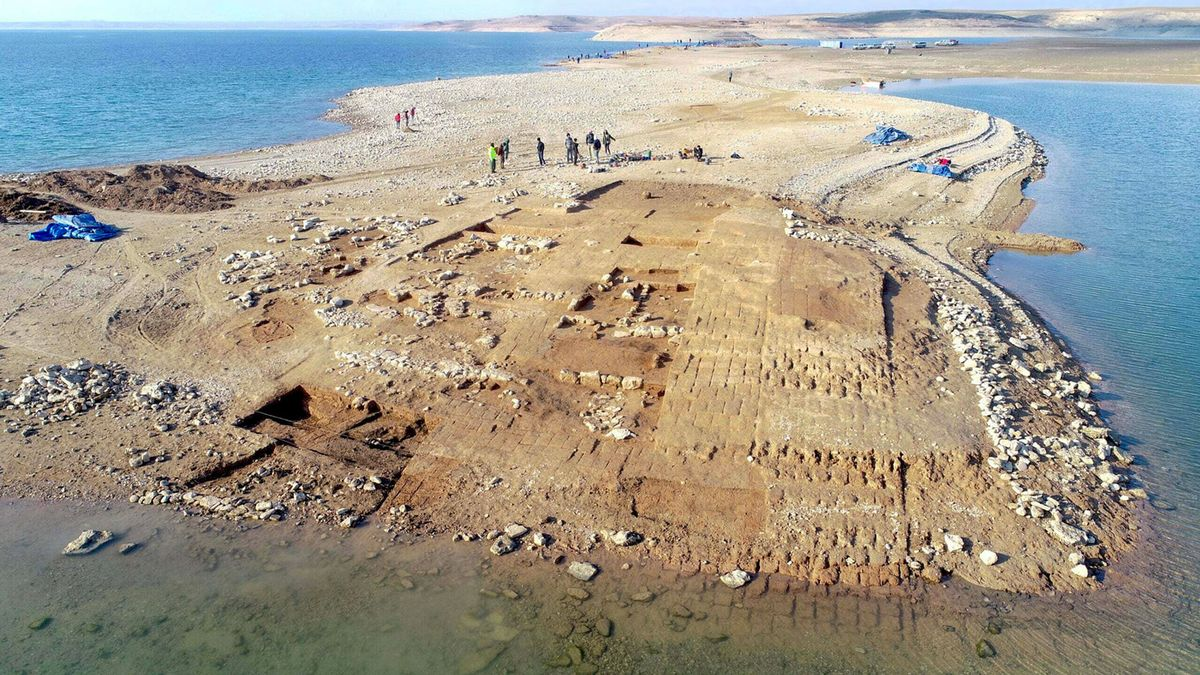
An ancient palace city has been discovered underwater in the Middle East. Archaeologists(考古学家) believed it to be the lost city of Zakhiku which was the centre of the Mitanni empire 3,400 years ago. It emerged from the waters of the Tigris River when part of the Mosul dam reservoir(水库) was out of water in what is now Iraq. The country is one of the worst hit by climate change, with temperatures rising to as high as 45 degrees, leaving residents with no other choice but to pull water from the reservoir for irrigation.
German and Kurdish excavators(发掘者) working at the site discovered ancient towers and writing tablets wrapped in clay envelopes. Walls measuring 10 feet high from thousands of years ago were found still standing, despite being made of sun-dried mud and submerged(淹没) in water. This is possibly due to an earthquake which turned the upper parts into rubble(碎石) serving as a protective cover over the centuries.
Dr Ivana Puljiz, assistant professor of archaeology at a university, said the ancient building used thousands of years ago was of particular importance. “Enormous quantities of goods must have been stored in it, probably brought from all over the region,” she explained. While Peter Pfälzner, an archaeology professor at Tübingen University, said the survival of the writing tablets was “close to a miracle”. Vibrant blue and red wall paintings, as well as a palace with 22ft high walls were also discovered at the site.
Researchers hope the latest discovery will offer more information about the fall of the city and the daily lives of its residents. The Mittani Empire once reached across from the Zagros Mountains in Iran to the Mediterranean. Discovered by divers close to Alikanas Bay in Greece, the site was believed to be the ruins of a lost civilization hidden beneath the waves. At the time, Professor Julian Andrews said: “The site was discovered by snorkelers and thought to be an ancient city port, lost to the sea. There were what superficially(表面地) looked like circular column bases, and paved floors. But mysteriously no other signs of life—such as pottery(陶器).”
本时文内容由奇速英语国际教育研究院原创编写,未经书面授权,禁止复制和任何商业用途,版权所有,侵权必究!(作者投稿及时文阅读定制请联系微信:18980471698)
1.What made the lost ancient palace city found?
A The drought.
B The earthquake.
C The writing tablet.
D The clay envelope.
解析:选A。A推理判断题。根据第一段的“It emerged from the waters of the Tigris River when part of the Mosul dam reservoir was out of water in what is now Iraq.”可以得知是因为干旱才导致了古城被发现。故选A。
2.Why could the ancient walls stand in water?
A They were made of sun-dried mud.
B They got the good protective cover.
C They were used for urgent irrigation.
D They measured as high as ten metres.
解析:选B。B 推理判断题。根据第二段最后一句的“This is possibly due to an earthquake which turned the upper parts into rubble serving as a protective cover over the centuries.”可以得知,地震将上部变成了碎石,给这些柱子包上了保护层,因此这些古城墙得以在水中矗立不倒。故选B。
3.What made the ancient building very important?
A It contained a large store of goods.
B It made the wall paintings vibrant.
C It helped the writing tablets survive.
D It held information about local residents.
解析:选A。A细节理解题。根据第三段的“the ancient building used thousands of years ago was of particular importance.” 可知Dr Ivana Puljiz认为这个古建筑非常重要;结合后一句的“Enormous quantities of goods must have been stored in it”可知,是因为那里储藏了大量的物品。故选A。
4.What will the researchers do in the excavation?
A Recover the ancient city.
B Build some circular columns.
C Climb Zagros Mountains.
D Find information about the residents.
解析:选D。D细节理解题。根据最后一段第一句的“Researchers hope the latest discovery will offer more information about the fall of the city and the daily lives of its residents.”可以得知,研究人员希望能在最新的发现中找到更多关于这座古城陷落和当地居民生活日常的信息。故选D。